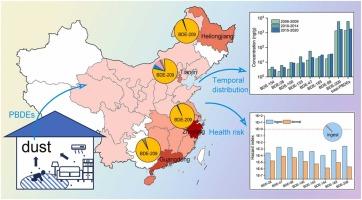2010 - 2022年中国家庭粉尘中多溴二苯醚的含量、分布、来源及儿童健康风险
引用次数: 0
摘要
多溴联苯醚(PBDEs)是家用产品中最常见的阻燃剂之一。鉴于多溴二苯醚的广谱毒性,监测室内环境中的多溴二苯醚水平并评估其潜在的健康风险对居民健康风险管理至关重要。方法基于2010 - 2022年已发表的文献数据,筛选26篇同行评议论文,详尽收集中国真实家庭生活条件下实际粉尘样本中多溴二苯醚浓度的具体原始数据。选择检出率超过80% %的同源基因(BDE-28, - 47, - 99, - 100, - 153, - 154, - 183, - 209)进行进一步分析。使用加权平均浓度对家庭粉尘多溴二苯醚水平进行量化。采用Mann-Whitney U检验和Kruskal-Wallis H检验评估季节和区域差异,采用Spearman相关分析和探索性因子分析(EFA)进行源分析。使用危害指数(HI)和致癌风险(CR)模型,根据通过摄入和皮肤吸收估计的每日摄入量(EDI)对儿童的健康风险进行评估。结果中国家庭粉尘中多溴二苯醚(HD-PBDEs)2的浓度范围为4.03 ng/g ~ 37333.58 ng/g,加权平均浓度为3625.43 ng/g。加权平均浓度以浙江最高(27268.66 ng/g),陕西最低(4.03 ng/g)。BDE-209是HD-PBDEs的优势同系物,分布范围为73.56 % ~ 99.78 %,其次是BDE-47(6.84 ~ 62.08 %)、BDE-99(1.80 ~ 56.77 %)和BDE-153(0 ~ 43.10 %)。2006-2009年∑8PBDEs的加权平均浓度为1419.97 ng/g, 2010-2014年为5886.15 ng/g, 2015-2020年为1813.51 ng/g。冬季HD-PBDE浓度显著高于春季和秋季(P <; 0.05)。居住在农村地区、南部地区或电子垃圾污染地区附近的家庭表现出更高的HD-PBDEs浓度(P <; 0.05)。提取两个主成分,占总方差的84.56 %。估计儿童每日通过食入摄入的多溴二苯醚(1.93 × 101 ng/kg BW/day)高于通过皮肤吸收(8.93 ×10−1 ng/kg BW/day)。HD-PBDEs的非致癌风险(1.01 ×10−1)和BDE-209的致癌风险(1.30 ×10−8)均低于标准标准。结论中国shd - pbde浓度在全球范围内处于中高水平,区域差异明显。中国儿童接触多溴二苯醚的非致癌性和致癌性风险均可接受。未来的调查应侧重于家庭环境中多溴二苯醚趋势的纵向监测以及对脆弱亚人群的健康影响。本文章由计算机程序翻译,如有差异,请以英文原文为准。

Levels, distribution, sources and children's health risk of PBDEs in household dust from 2010 to 2022 in China
Background
Polybrominated biphenyl ethers (PBDEs) are one of the most common flame retardants in household products. Given their broad-spectrum toxicity, monitoring PBDE levels in indoor environments and assessing their potential health risks are critical for residential health risk management.
Methods
Based on published literature data from 2010 to 2022, the concrete raw data regarding the concentration of PBDEs in actual dust samples from true household living conditions in China were collected exhaustively from 26 peer-reviewed papers after screening. Congeners with detection rates exceeding 80 % (BDE-28, −47, −99, −100, −153, −154, −183, −209) were selected for further analysis. Household dust PBDE levels were quantified using the weighted average concentration. Seasonal and regional variations were evaluated using the Mann-Whitney U and Kruskal-Wallis H tests, while Spearman correlation analysis and exploratory factor analysis (EFA) were applied for source apportionment. Health risks to children were assessed based on estimated daily intake (EDI) via ingestion and dermal absorption, using hazard indices (HI) and carcinogenic risk (CR) models.
Results
The concentrations of PBDEs in household dust (HD-PBDEs)2 in China ranged from 4.03 ng/g to 37333.58 ng/g, with a weighted average concentration of 3625.43 ng/g. The weighted average concentration was maximum in Zhejiang (27268.66 ng/g) and lowest in Shaanxi (4.03 ng/g). BDE-209 was the predominant congener of HD-PBDEs, ranging from 73.56 % to 99.78 %, followed by BDE-47 (6.84–62.08 %), BDE-99 (1.80–56.77 %), and BDE-153 (0–43.10 %). The weighted average concentrations of ∑8PBDEs were 1419.97 ng/g in 2006–2009, 5886.15 ng/g in 2010–2014, and 1813.51 ng/g in 2015–2020. HD-PBDE concentration was significantly higher in winter than in spring and fall (P < 0.05). Families residing in rural areas, southern regions, or near e-waste-contaminated areas exhibited higher concentrations of HD-PBDEs (P < 0.05). Two principal components were extracted, accounting for 84.56 % of the total variance. The estimated daily intake of HD-PBDEs for children via ingestion (1.93 × 101 ng/kg BW/day) was higher than that via dermal absorption (8.93 ×10−1 ng/kg BW/day). The non-carcinogenic risk of HD-PBDEs (1.01 ×10−1) and the carcinogenic risk of BDE-209 (1.30 ×10−8) were below the standard criterion.
Conclusions
HD-PBDE concentrations in China ranked moderate-to-high globally, with clear regional variations. Both non-carcinogenic and carcinogenic risks of HD-PBDE exposure to Chinese children were acceptable. Future investigations should focus on longitudinal monitoring of PBDE trends in household environments and health impacts on vulnerable subpopulations.
求助全文
通过发布文献求助,成功后即可免费获取论文全文。
去求助

 求助内容:
求助内容: 应助结果提醒方式:
应助结果提醒方式:


